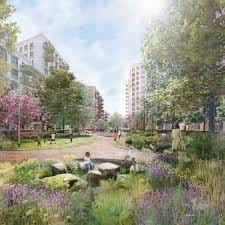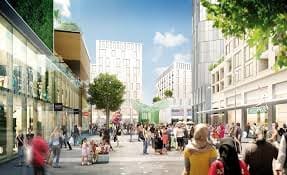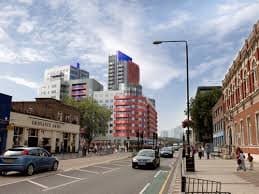Introduction
Nestled in East London, Canning Town is a neighbourhood that has undergone a remarkable journey. Once a working-class dockland area tied closely to the shipping and industrial heritage of the Thames, it is now one of the most exciting and rapidly developing corners of the capital. Over the years, it has evolved from a gritty industrial hub to a vibrant, multicultural urban community with new housing developments, excellent transport links, and a strong sense of local pride.
Canning Town’s story is not just about regeneration—it’s about resilience. Generations of families have called it home, and newcomers continue to add to its cultural richness. Today, it blends history with modernity, diversity with unity, and tradition with innovation. This article explores 20 positive aspects of Canning Town, celebrating its transformation, community spirit, and bright future.
1. The Transformation of Canning Town
Over the last two decades, Canning Town has experienced one of London’s most ambitious regeneration programs. Once overshadowed by industrial decline, it is now a place of opportunity, with upgraded housing, improved public spaces, and bustling new business areas. The skyline now boasts modern apartment complexes alongside refurbished historic buildings, showing a clear balance between past and present.
2. Historic Roots of Canning Town
Canning Town’s roots lie deep in the history of London’s docklands. In the 19th and early 20th centuries, it was a hub for dock workers and shipbuilders. Though life was often tough, the community developed a strong working-class identity and resilience. Preserving these historical connections—through heritage projects, plaques, and storytelling—remains an important part of its identity.
3. Canning Town and the River Thames
The Thames has always been central to Canning Town’s existence. Its role in maritime trade brought jobs and people from around the world, shaping the area’s diversity. Today, riverside developments and walking routes are reconnecting the community to the water, offering leisure spaces where history meets modern recreation.
4. Urban Renewal Projects
From brand-new housing estates to improved public amenities, urban renewal is transforming the neighbourhood. The Canning Town and Custom House Regeneration Programme, backed by Newham Council, aims to deliver thousands of new homes, better transport connections, green spaces, and retail opportunities. These upgrades are designed not just for aesthetics but to improve the quality of life for residents.
5. Modern Architecture
Canning Town’s regeneration has brought eye-catching architecture into the mix. Residential towers with striking glass facades now stand alongside low-rise modern flats and redeveloped Victorian terraces. The architecture reflects London’s evolving skyline while keeping a touch of local character.
6. Boosting Local Business
The influx of residents and improved infrastructure has breathed new life into the local economy. Independent cafés, restaurants, and shops are thriving alongside established markets. Pop-up stalls, street food vendors, and start-up businesses find Canning Town an affordable, well-connected base.
7. Community Spirit
Despite all the changes, Canning Town remains a place where neighbours look out for one another. Local organisations run food drives, charity events, and cultural celebrations, keeping the sense of belonging alive. It’s this grassroots strength that has kept Canning Town united through decades of change.
8. Cultural Diversity
Few areas of London can match Canning Town’s cultural mix. Residents from across the globe contribute to a vibrant atmosphere reflected in its shops, restaurants, and festivals. From Caribbean street food to South Asian curries and African drumming events, cultural exchange happens every day here.
9. Local Markets and Food Culture
Rathbone Market has been a cornerstone of Canning Town for decades, offering fresh produce, clothing, and household goods. Today, it blends traditional market stalls with modern traders selling street food, artisan bread, and international delicacies—creating a flavourful snapshot of the area’s diversity.
10. Sports and Recreation
Sports are deeply rooted in Canning Town’s identity. Local football clubs, boxing gyms, and community sports centres offer opportunities for all ages to get active. The area is also home to green gyms, fitness classes, and cycling groups, making healthy lifestyles more accessible.
11. Excellent Transport Links
Canning Town is one of the most connected neighbourhoods in London. Served by the Jubilee Line, Docklands Light Railway (DLR), and numerous bus routes, it offers quick access to Canary Wharf, Stratford, and Central London. For commuters and travellers alike, its location is unbeatable.
12. Cycling and Walking Routes
Beyond public transport, Canning Town offers safe and scenic walking and cycling paths. Routes along the Lea River and the Thames provide pleasant commutes and weekend strolls. The area’s growing network of cycle lanes is part of London’s push toward greener, healthier travel.
13. Schools and Learning Centres
Canning Town offers a range of educational opportunities, from primary schools to adult learning centres. Schools like Hallsville Primary and St Luke’s have strong reputations, and nearby colleges provide vocational training and higher education pathways for young people and adults alike.
14. Youth Programs
Numerous local organisations run youth clubs, mentoring schemes, and creative workshops. These programs focus on building skills, offering safe spaces, and encouraging positive futures. They are an essential part of keeping young people engaged and inspired.
15. Parks and Open Spaces
Urban regeneration has brought more green areas to Canning Town, including improved playgrounds, landscaped gardens, and small parks. These spaces not only offer relaxation but also strengthen community bonds as families and neighbours gather outdoors.
16. Sustainable Development
Canning Town’s new developments increasingly feature eco-friendly designs—energy-efficient housing, rainwater harvesting, and green roofs are becoming more common. Sustainability is being built into the area’s growth, making it a model for responsible urban renewal.
17. Art and Creativity
Street art, murals, and local galleries showcase the creative talent of Canning Town residents. Public art projects often involve community members, turning regeneration into an inclusive process that values self-expression.
18. Festivals and Events
Canning Town’s calendar is full of events that celebrate its diversity. Food festivals, music nights, cultural showcases, and seasonal fairs draw people together, creating a lively local culture that thrives year-round.
19. An Emerging London Hotspot
With its regeneration, affordability (compared to central London), and excellent transport links, Canning Town is gaining attention from homebuyers, investors, and young professionals. It’s no longer just a pass-through area—it’s becoming a destination in its own right.
20. Vision for 2030
Looking ahead, Canning Town’s future is bright. Plans include more affordable housing, expanded green spaces, improved shopping areas, and even better transport connectivity. By 2030, it could stand as a model for how to blend heritage, diversity, and modernity into a thriving urban neighbourhood.
Conclusion
Canning Town is a living example of resilience and renewal. From its dockland past to its ambitious future, it represents the strength of community spirit, the benefits of thoughtful urban planning, and the beauty of cultural diversity. As it grows, it continues to balance its historic roots with the demands of a modern, connected London—making it a place worth celebrating.





